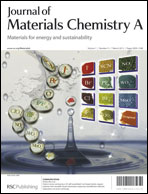Facile in situ synthesis of a Bi/BiOCl nanocomposite with high photocatalytic activity†
Abstract
This paper presents a novel and facile method to fabricate a Bi/BiOCl nanocomposite with dominant (001) facets in situ via a UV light-induced chemical reduction route under mild conditions. Different characterization techniques, including X-ray diffraction (XRD), field-emission scanning electron microscopy (FE-SEM), transmission scanning electron microscopy (TEM), UV-vis diffuse reflectance spectrometry (DRS), Raman scattering, photoluminescence spectroscopy (PL), and electron spin resonance spectroscopy (ESR), have been used to investigate the structure and properties of the Bi/BiOCl nanocomposite. The variation in the photoelectric response before and after the deposition of Bi on the BiOCl nanosheets is investigated by a photoelectrochemical experiment. It is found that the properties of the samples, including their optical and electrical properties, can be tuned by the addition of Bi metal. The in situ incorporation of Bi into the semiconductor BiOCl nanosheets can efficiently enhance the photocatalytic performance of BiOCl for the degradation of methyl orange (MO). To the best of our knowledge, it is the first time a Bi/BiOCl nanocomposite has been utilized as a photocatalyst for the degradation of pollutants under mild conditions. The high photodegradation activity of the Bi/BiOCl nanocomposite can be ascribed to the presence of Bi metal, which can enhance the light absorption intensity, efficiently separate photogenerated electron–hole pairs, and accelerate the interfacial charge-transfer rate.


 Please wait while we load your content...
Please wait while we load your content...